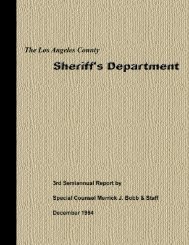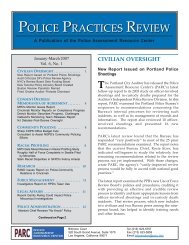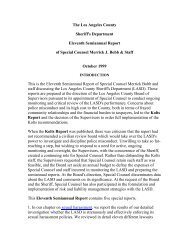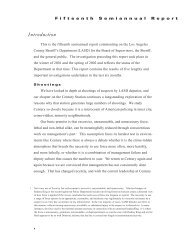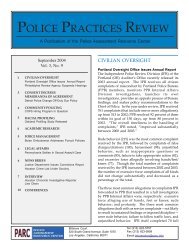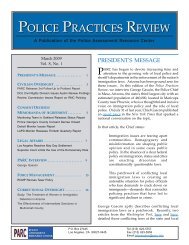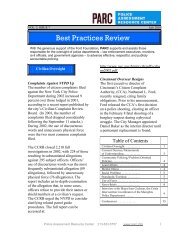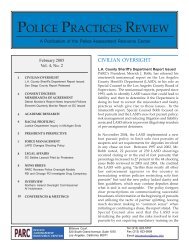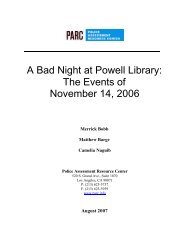July - Police Assessment Resource Center
July - Police Assessment Resource Center
July - Police Assessment Resource Center
Create successful ePaper yourself
Turn your PDF publications into a flip-book with our unique Google optimized e-Paper software.
VOL. 1, ISSUE 3 <strong>July</strong> 2002<br />
Table of Contents<br />
BEST PRACTICES REVIEW<br />
PARC supports and assists those responsible for the oversight of police departments – law<br />
enforcement executives, monitors, civil officials, and government agencies – to advance<br />
effective, respectful, and publicly accountable policing.<br />
Agencies Under Investigation 1<br />
Civilian Oversight . . . . . . . . . . 1<br />
Community Policing/Problem<br />
Oriented Policing . . . . . . . . . . 3<br />
Consent Decrees/Memoranda<br />
of Understanding . . . . . . . . . . 4<br />
Litigation . . . . . . . . . . . . . . . . . . 4<br />
Mental Illness . . . . . . . . . . . . . . 5<br />
Racial Profiling . . . . . . . . . . . . . 6<br />
Standards/Training . . . . . . . . . 7<br />
Use of Force . . . . . . . . . . . . . . 10<br />
Interview . . . . . . . . . . . . . . . . 11<br />
Conferences . . . . . . . . . . . . . . 15<br />
Agencies Under Investigation<br />
The Schenectady, New York <strong>Police</strong><br />
Department released an update on<br />
departmental reforms. The update<br />
states that, although none of the 20 steps<br />
outlined in the plan to reform the<br />
department have been completed,<br />
significant advances and<br />
accomplishments have been made,<br />
including: Commencement of<br />
specialized training of the department’s<br />
first canine officer; purchase orders have<br />
been signed to buy in-car video cameras<br />
to be installed in patrol cars; and three<br />
officers have been trained and certified<br />
to teach ethics and integrity to other<br />
officers. The department is also<br />
expected to release results from a survey<br />
of officers’ attitudes towards their job<br />
and the community they serve. Albany<br />
Times Union, June 10, 2002.<br />
Civilian Oversight<br />
A one-year pilot program of the Denver<br />
Disciplinary Review Board will<br />
commence operations in <strong>July</strong> 2002. The<br />
Board will consist of volunteers from<br />
the police department and the citizens<br />
police academy and will review cases in<br />
which an officer faces a fine, suspension,<br />
demotion or termination. Board<br />
members will review the case, hear<br />
testimony from the department and the<br />
subject officer, and give disciplinary<br />
recommendations to the police chief,<br />
who has ultimate authority to accept or<br />
reject the Board’s recommendations.<br />
The volunteers were required to attend<br />
eight hours of additional training,<br />
beyond civilian academy training, to be<br />
on the Board. The Board will consist of<br />
two civilians, two officers and two<br />
command officers. The police protection<br />
association initially presented the idea<br />
for the Board to the department in April<br />
2000. Rocky Mountain News, June 7, 2002.<br />
The <strong>Police</strong> <strong>Assessment</strong> <strong>Resource</strong> <strong>Center</strong><br />
and independent consultant Richard<br />
Jerome released a report evaluating the<br />
city of Albuquerque’s police oversight<br />
<strong>Police</strong> <strong>Assessment</strong> <strong>Resource</strong> <strong>Center</strong> 213-623-5757 www.parc.info 1
VOL. 1, ISSUE 3 <strong>July</strong> 2002<br />
system. The report concludes that<br />
internal police investigations were<br />
improved as a result of adoption of the<br />
oversight system, but significant<br />
improvements must be made.<br />
Albuquerque’s oversight system<br />
consists of the Independent Review<br />
Office (IRO), which reviews and<br />
investigates citizen complaints, and the<br />
<strong>Police</strong> Oversight Commission (POC), a<br />
civilian board that hears citizen<br />
complaint appeals. The consultants felt<br />
that the IRO conducted quality<br />
investigations and served as an<br />
important check and balance to the<br />
Internal Affairs Unit, citing the former<br />
<strong>Police</strong> Chief’s occasional preference for<br />
the IRO’s recommendations over IA’s as<br />
evidence. However, the IRO failed to<br />
utilize its authority to perform<br />
systematic evaluation of APD policies<br />
and procedures to identify trends and<br />
patterns of misconduct, particularly<br />
regarding use of force. The report<br />
asserts that POC faces structural<br />
impediments, including lack of access to<br />
investigative files and officer statements<br />
and the failure of officers to attend<br />
hearings, which prevent it from<br />
functioning effectively. The consultants<br />
propose that the POC have access to<br />
completed IA files, and proceedings be<br />
held in closed session. Also, the IRO<br />
and POC should improve community<br />
relations and the POC should improve<br />
its relations with the police. Lastly, the<br />
report concludes that APD has<br />
improved its early warning system, use<br />
of force reporting system and Crisis<br />
Intervention Team for dealing with the<br />
emotionally disturbed. The full report<br />
can be accessed electronically at<br />
http://www.cabq.gov/council/pocstud<br />
y.pdf.<br />
The Providence, Rhode Island City<br />
Council approved a measure to create<br />
the Providence External Review<br />
Authority, which would independently<br />
investigate citizen complaints of police<br />
misconduct and recommend disciplinary<br />
action to the police chief. The measure<br />
must receive the Mayor’s approval and<br />
the appropriate allocation from the<br />
2002-2003 municipal budget. The<br />
measure also must undergo a public<br />
hearing and must be found to be in<br />
accord with the Law Enforcement<br />
Officers Bill of Rights prior to final<br />
approval. Providence Journal, June 21,<br />
2002.<br />
John Worrall has written, “If You Build<br />
It, They Will Come: Consequences of<br />
Improved Citizen Complaint Review<br />
Procedures,” based on a study of over<br />
700 law enforcement agencies that<br />
modified their civilian complaint<br />
mechanism. Worrall concludes that<br />
researchers, policy makers and law<br />
enforcement agencies must be aware<br />
that improvements in civilian complaint<br />
procedures correlate with an increased<br />
number of complaints. Further, he<br />
asserts that it is not surprising that an<br />
innovative citizen complaint model that<br />
attempts to develop a more open,<br />
responsive environment generates more<br />
complaints than a traditional model that<br />
has been deemed hostile to certain<br />
individuals (including African<br />
Americans, the poor or unemployed,<br />
and the less educated). Worrall<br />
discusses the advantages, pitfalls, and<br />
similarities of four citizen complaint<br />
mechanisms: internal investigation and<br />
complaint adjudication systems; citizen<br />
review; early warning systems and<br />
electronic complaint databases. He also<br />
analyzes the relationship between such<br />
mechanisms and other variables, such as<br />
officer training, education, job hazards,<br />
crime rates and unemployment rates.<br />
<strong>Police</strong> <strong>Assessment</strong> <strong>Resource</strong> <strong>Center</strong> 213-623-5757 www.parc.info 2
VOL. 1, ISSUE 3 <strong>July</strong> 2002<br />
Worrall’s key findings include:<br />
Increased officer training and education<br />
correlates with fewer complaints; no<br />
significant differences exist in the<br />
number of complaints received in<br />
internal versus external complaint<br />
entities; and departmental resources<br />
(including early warning systems and<br />
other computerized risk-assessment<br />
databases) tend to result in a higher<br />
incidence of citizen complaints. To<br />
elucidate the last finding, the author<br />
suggests that departments with<br />
databases may maintain more accurate<br />
records of complaints than those that do<br />
not and may also convey more<br />
professionalism and concern to citizens,<br />
leading them to feel more comfortable<br />
filing complaints. Crime and<br />
Delinquency, <strong>July</strong> 2002.<br />
Community Policing/<br />
Problem Oriented Policing<br />
Local press and community leaders<br />
continue to express concern about racial<br />
tensions in the city of Cincinnati. In<br />
April, the Cincinnati <strong>Police</strong> Department<br />
entered into two separate agreements,<br />
one with the U.S. Department of Justice<br />
and a separate “collaborative<br />
agreement” with a consortium of civil<br />
rights groups, to reform police policies<br />
and practices and improve policecommunity<br />
relations, particularly<br />
within the city’s African American<br />
communities. In an effort to alleviate<br />
racial tensions, a Cincinnati City<br />
Councilman proposed that the city<br />
provide $75,000 to hire 10 community<br />
human relations monitors to walk in<br />
communities, talk to residents, assess<br />
neighborhood moods, and identify<br />
potential problem areas. Several city<br />
council members are opposed to the<br />
plan. Cincinnati Enquirer, June 19, 2002.<br />
Crime and Delinquency has published,<br />
“Implementing Community-Oriented<br />
Policing (COP): Organizational Change<br />
and Street Officer Attitudes.” Authors<br />
Adams, Rohe and Arcury examine how<br />
COP training and COP officer<br />
designation are associated with<br />
attitudes toward COP principles, job<br />
satisfaction and support for COP. The<br />
authors analyze survey data from 285<br />
non-supervisory officers in six small<br />
and mid-size law enforcement agencies.<br />
The authors found that community<br />
police officers are more supportive of<br />
COP goals and methods, spend more<br />
time engaged in COP activities, are<br />
more supportive of organizational<br />
changes needed to implement COP, and<br />
report higher levels of job satisfaction<br />
than traditional officers. They also<br />
found that officers who perceived their<br />
departments as having a participatory<br />
management style were more positive<br />
about community policing and reported<br />
greater job satisfaction. In addition, the<br />
majority of traditional officers<br />
supported COP goals and the transition<br />
to COP in their departments. Crime and<br />
Delinquency, <strong>July</strong> 2002.<br />
The Office of Community Oriented<br />
Policing Services is requesting feedback<br />
on the regional community policing<br />
institute quarterly report (form number<br />
COPS 022/01). COPS seeks to monitor<br />
the progress and use of funds by the<br />
Regional Community Policing Institutes<br />
through one-year cooperative<br />
agreements to provide technical<br />
assistance and training to grantees and<br />
other participants. For more<br />
information, please contact Brenda<br />
Dyer, Management Division,<br />
Department of Justice, Patrick Henry<br />
Building, Suite 1600, 601 D St.,<br />
Washington, DC 20530.<br />
<strong>Police</strong> <strong>Assessment</strong> <strong>Resource</strong> <strong>Center</strong> 213-623-5757 www.parc.info 3
VOL. 1, ISSUE 3 <strong>July</strong> 2002<br />
Consent Decrees/Memoranda of<br />
Understanding<br />
The Office of the Independent Monitor<br />
for the Washington D.C. Metropolitan<br />
<strong>Police</strong> Department (“MPD”) has<br />
released its first report. The report<br />
states that the Department has made<br />
substantial efforts towards compliance<br />
in many areas covered in the<br />
Memorandum of Agreement between<br />
the U.S. Department of Justice and<br />
MPD. However, according to the<br />
report, MPD has failed to accomplish<br />
nearly all of the objectives identified in<br />
the MOA within the specified time<br />
frames; the MPD is not in compliance<br />
with creating and implementing new<br />
firearms, canine and OC spray policies<br />
and creating an early warning system;<br />
and the MPD has also made little<br />
progress in revising its discipline and<br />
non-discipline policy and effectively<br />
modifying its civilian complaint<br />
procedures. The monitor identifies<br />
many significant improvements made<br />
by MPD, including: Developing a<br />
revised Use of Force policy; enhancing<br />
training; creating a new team to<br />
investigate Use of Force incidents; and<br />
reorganizing the canine unit. The full<br />
report can be accessed electronically at<br />
http://www.policemonitor.org/.<br />
Litigation<br />
Several law enforcement unions in<br />
California are preparing legal action<br />
regarding Brady policies. Brady v.<br />
Maryland, 373 U.S. 87 (1962), requires all<br />
exculpatory or potentially impeachable<br />
evidence be handed over to defense<br />
attorneys. The Los Angeles <strong>Police</strong><br />
Protective League is preparing to sue<br />
Los Angeles County District Attorney<br />
Steve Cooley over his new Brady policy<br />
that allows additional information on<br />
police officers involved in criminal cases<br />
to be turned over to the defense. In May<br />
2002, Cooley revealed his Brady policy.<br />
Cooley claims that the policy was<br />
intentionally worded to avoid police<br />
union lawsuits alleging officer privacy<br />
rights violations. <strong>Police</strong> union officials<br />
and prosecutors seem particularly<br />
concerned with the D.A.’s creation of a<br />
database that will contain legal and<br />
board of rights hearing documents.<br />
Former Los Angeles County District<br />
Attorney Gil Garcetti was sued by the<br />
<strong>Police</strong> Protective League in October 2000<br />
for creation of a similar database. The<br />
lawsuit was dropped after Cooley took<br />
office and abandoned the project. The<br />
Santa Barbara D.A. is also being sued<br />
over a Brady policy he created in 2001.<br />
<strong>Police</strong> Union officials in Ventura<br />
County, California are preparing for a<br />
potential lawsuit if their department<br />
definitively decides to implement its<br />
own Brady policy. Pitchess v. Superior<br />
Court created a legal precedent in<br />
California Supreme Court that protects<br />
elements of an officer’s personnel files<br />
from being made public. Los Angeles<br />
Daily Journal, June 5, 2002.<br />
The city of Pittsburgh agreed to settle 32<br />
pending police abuse lawsuits for a total<br />
of $275,000. The city admitted no<br />
wrongdoing, but agreed to settle as an<br />
alternative to a potentially long and<br />
costly legal battle. The cases were<br />
among more than 40 brought against<br />
police as part of a 1996 lawsuit by the<br />
American Civil Liberties Union. The<br />
settlement is pending awaiting the City<br />
Council’s approval. Pittsburgh Post-<br />
Gazette, June 20, 2002.<br />
The city of Modesto, California agreed<br />
to pay $2.55 million to the family of 11<br />
<strong>Police</strong> <strong>Assessment</strong> <strong>Resource</strong> <strong>Center</strong> 213-623-5757 www.parc.info 4
VOL. 1, ISSUE 3 <strong>July</strong> 2002<br />
year-old Alberto Sepulveda, who was<br />
accidentally shot and killed during a<br />
September 2000 drug raid. In addition<br />
to monetary compensation, Modesto<br />
<strong>Police</strong> Chief Roy Wasden agreed to<br />
change MPD’s procedures to prevent<br />
accidental shootings in the future.<br />
Changes include: Written policies<br />
prohibiting officers from pointing their<br />
guns at persons who comply with police<br />
orders; prohibiting taking witnesses to<br />
the police station without their consent;<br />
and prohibiting taking children to the<br />
police station without first advising<br />
their parents. Modesto Bee, June 20, 2002.<br />
Mental Illness<br />
Criminal Justice and Behavior published a<br />
study titled, “<strong>Police</strong> Handling of the<br />
Mentally Ill in Domestic Violence<br />
Situations.” Authors Mary Finn and<br />
Loretta Stalans found that officers that<br />
recognize persons as mentally ill<br />
perceived them as more dangerous, less<br />
credible, more responsible for the<br />
violence, less in control of their actions<br />
and less likely to be acting in self<br />
defense. They found that officers who<br />
held stereotypic views supportive of<br />
violence, or those that blamed the<br />
victim, were less likely to arrest. The<br />
study also found a positive, statistically<br />
significant correlation between officers’<br />
views of the mental health system and<br />
the decision to request civil<br />
commitment. Criminal Justice and<br />
Behavior, June 2002.<br />
The Criminal Justice/Mental Health<br />
Consensus Project, a two year<br />
collaborative project of the Council of<br />
State Governments, the National<br />
Association of State Mental Health<br />
Program Directors, law enforcement<br />
officials, criminal justice experts, mental<br />
health experts and consumers released a<br />
report detailing the project’s results.<br />
The Consensus Project report provides<br />
recommendations that local, state, and<br />
federal policymakers, criminal justice<br />
and mental health professionals, and<br />
law enforcement officials can use to<br />
improve their response to people with<br />
mental illness and provides ‘model’<br />
examples to follow. The report states<br />
that police are often the first contact a<br />
mentally ill person will have with the<br />
criminal justice system. Therefore, it is<br />
crucial that officers have adequate<br />
knowledge of mental health issues and<br />
symptoms, de-escalation training and<br />
possess the ability to assess whether the<br />
crime necessitates criminal justice action<br />
or is best addressed through alternative<br />
mental health sources. The report states<br />
that police dispatch personnel should be<br />
provided with tools, including<br />
appropriate questions to be asked, to<br />
assess whether mental illness may be a<br />
factor in a call for service. Departments<br />
should develop procedures that require<br />
officers to assess whether mental illness<br />
is a factor in an incident. The report<br />
suggests that departments establish<br />
written protocols that delineate<br />
appropriate officer responses based on<br />
the specific nature of the incident.<br />
Documentation of all contacts with<br />
mentally ill persons will promote<br />
accountability and enhance service<br />
delivery. Lastly, departments should<br />
form partnerships with mental health<br />
professionals and/or create a<br />
specialized crisis team that responds to<br />
incidents involving the mentally ill. The<br />
full report can be accessed electronically<br />
at http://www.consensusproject.org/<br />
downloads/Chapter_II.pdf.<br />
<strong>Police</strong> <strong>Assessment</strong> <strong>Resource</strong> <strong>Center</strong> 213-623-5757 www.parc.info 5
VOL. 1, ISSUE 3 <strong>July</strong> 2002<br />
Racial Profiling<br />
The New Jersey State traffic stop study,<br />
which was released in March 2002 and<br />
which concluded that black drivers<br />
were more likely to speed than whites,<br />
created a debate about the merits of<br />
collecting traffic data. Policy makers,<br />
police `experts and executives have<br />
questioned the importance of spending<br />
considerable time and resources in<br />
collecting traffic stop data given the<br />
purported lack of methodologically<br />
sound means to analyze the data. The<br />
Law Enforcement News reports that some<br />
cities collect data, but fail to analyze the<br />
data. Other cities that conduct analyses<br />
have concluded that comparisons create<br />
an incomplete and potentially<br />
misleading picture of police activity.<br />
Seattle City Council members have<br />
suggested eliminating mandatory data<br />
collection and alternatively using the<br />
money to install video cameras in patrol<br />
cars. Others argue that, while data<br />
collection may have its limitations, it<br />
does provide a glimpse of possible<br />
patterns and trends. Law Enforcement<br />
News, April 15, 2002.<br />
The <strong>Police</strong> Executive Research Forum<br />
(“PERF”) released a report on its COPSfunded<br />
racially biased policing project.<br />
The report is based on information<br />
obtained from focus groups, surveys of<br />
over 1,000 police executives, police<br />
department material and meetings with<br />
police chiefs and civil rights groups.<br />
The report provides suggestions to<br />
police department executives to combat<br />
racially biased policing, including<br />
developing an anti-biased policing<br />
policy, modifying recruitment and<br />
hiring practices and increased<br />
supervision and accountability. The<br />
report also suggests more training and<br />
education for officers, community<br />
outreach and traffic stop data collection.<br />
The report is available on PERF’s<br />
website at www.policeforum.org.<br />
A voluntary traffic stop data collection<br />
study conducted by the Oregon State<br />
<strong>Police</strong> revealed that white drivers are<br />
stopped most often, but arrests per stop<br />
were higher for minorities. Oregon has<br />
an 88 percent white population and<br />
white motorists represent 89 percent of<br />
all stops. Once stopped, troopers<br />
conducted searches of 1.79 percent and<br />
arrested .69 percent of white motorists.<br />
Troopers searched 3.6 percent and<br />
arrested 1.45 percent of Hispanic<br />
drivers. Troopers searched 2.9 percent<br />
and arrested .85 of black motorists.<br />
Oregon State <strong>Police</strong> Superintendent<br />
Ronald Rucker stated that the data<br />
collection study was the department’s<br />
first step in addressing community<br />
concerns about racial profiling. Crime<br />
Control Digest, May 10, 2002.<br />
The Seattle City Council approved a<br />
data-collection plan that would require<br />
police officers to fill out a questionnaire<br />
each time a motorist is stopped that<br />
would include: The driver's gender, age<br />
and residence; time, date and location of<br />
stop; the reason and outcome of the<br />
stop; the officer’s assumption about the<br />
driver's race and whether the officer had<br />
identified the driver's race prior to the<br />
stop; the duration of the stop; the<br />
number of passengers; whether the<br />
driver was asked to step out of the car;<br />
whether a search was conducted; the<br />
basis for the search; what items were<br />
found during the search; and the<br />
officer's squad assignment. The Mayor<br />
announced that he may not support the<br />
proposal. <strong>Police</strong> Chief Gil Kerlikowske<br />
also expressed concern about possible<br />
misuse of the data and the lack of a<br />
<strong>Police</strong> <strong>Assessment</strong> <strong>Resource</strong> <strong>Center</strong> 213-623-5757 www.parc.info 6
VOL. 1, ISSUE 3 <strong>July</strong> 2002<br />
sound methodology to analyze the<br />
results. A second companion measure<br />
to install 25 video cameras in patrol cars<br />
was approved by the council on June 19,<br />
2002. The City and police union are<br />
negotiating the terms of this measure.<br />
Seattle Times, June 20, 2002.<br />
On June 6, 2002, Portland, Oregon <strong>Police</strong><br />
Chief Mark Kroeker announced that a<br />
racial profiling panel, consisting of<br />
<strong>Police</strong> Bureau personnel and<br />
community members, will reconvene<br />
after 2001 traffic stop data have been<br />
analyzed. The data showed that police<br />
were more than twice as likely to stop<br />
African Americans than white<br />
motorists. From <strong>July</strong> through December<br />
2001, police stopped 210 African<br />
American motorists per 1,000 African<br />
American residents. <strong>Police</strong> stopped 102<br />
whites per 1,000 white residents. During<br />
the first six months of 2001, police<br />
stopped 240 African Americans and 90<br />
whites per 1,000 residents. Kroeker<br />
suggested that changes in data<br />
collection during the second half of the<br />
year could explain the differences. Data<br />
from motorcycle, mounted and bicycle<br />
patrols were not available until <strong>July</strong><br />
2001. Asians and Native Americans<br />
made up a smaller percentage of stops<br />
than their share of the population and<br />
Latinos were slightly more likely than<br />
whites to be stopped. Kroeker stated<br />
that the results are inconclusive, in that<br />
comparisons based on resident<br />
population may not be valid because<br />
police officers stop non-residents and<br />
because some motorists have been<br />
stopped numerous times. Kroeker<br />
expressed his wish to employ racial<br />
profiling experts who specialize in<br />
innovative data analysis to interpret the<br />
results. The Oregonian, June 6, 2002.<br />
Standards/Training<br />
PERF and author Mark Moore have<br />
released a publication to help policy<br />
makers, police professionals, and<br />
citizens evaluate police agencies and<br />
practices. “Recognizing Value in<br />
Policing,” examines seven goals of<br />
policing and suggests that traditional<br />
measures of police performance are<br />
inadequate. Moore based his<br />
conclusions on collaborative work with<br />
leading criminal justice practitioners<br />
and research conducted in several cities.<br />
The report is available for purchase on<br />
PERF’s website at<br />
www.policeforum.org.<br />
A study conducted by the U.S.<br />
Department of Justice concludes that<br />
police departments in large cities are<br />
requiring new officers to have more<br />
education and training than in the past,<br />
but are paying them less. In 2000, 37<br />
percent of police departments serving<br />
cities of 250,000 or more required new<br />
officers to meet a college education<br />
requirement, compared with 19 percent<br />
in 1990. Departments requiring a two or<br />
four year degree increased from 6 to 14<br />
percent. The number of classroom and<br />
field training hours increased from 1,280<br />
to 1,480 over the same time period.<br />
After controlling for inflation, officer<br />
salaries declined from $35,002 to<br />
$34,556. The report also addresses<br />
changes in racial and ethnic minority<br />
employment, the development of<br />
special units and the use of airplanes<br />
and bicycles for policing activities. The<br />
full 16-page report is available from the<br />
Bureau of Justice Statistics<br />
Clearinghouse at 1-800-732-3277 or<br />
online at www.ojp.usdoj.gov/bjs.<br />
<strong>Police</strong> <strong>Assessment</strong> <strong>Resource</strong> <strong>Center</strong> 213-623-5757 www.parc.info 7
VOL. 1, ISSUE 3 <strong>July</strong> 2002<br />
IACP’s <strong>Police</strong> Chief has published an<br />
article on the role of Internal Affairs and<br />
the Chief of <strong>Police</strong> in providing<br />
leadership in integrity and ethics.<br />
Author Richard E. Lober, of the<br />
Tallahassee Department of Law<br />
Enforcement, suggests that Chiefs<br />
should: Identify the department’s<br />
current cultural values; establish core<br />
values within the ranks; put core values<br />
into daily operation; incorporate core<br />
values into all training; and select field<br />
training officers and supervisors<br />
carefully for strong values. Lober<br />
suggests that both what Internal Affairs<br />
chooses to investigate and the quality of<br />
the investigations imbues integrity and<br />
ethics into police officer attitudes. He<br />
also suggests that Internal Affairs’<br />
findings and any discipline imposed<br />
should reflect the department’s core<br />
values. <strong>Police</strong> Chief, May 2002.<br />
The <strong>Police</strong> Quarterly has published,<br />
“Technology, Policing and Implications<br />
of In-Car Videos.” Authors Maghan,<br />
O’Reilly and Shun review the benefits<br />
on in-car video technology, highlight<br />
possible officer resistance, and provide<br />
suggestions to departments considering<br />
this technology. They argue that in-car<br />
videos can deter officer abuse, serve as<br />
evidence that can minimize frivolous<br />
citizen complaints against officers, and<br />
assist in restoring and increasing public<br />
confidence in a law enforcement agency.<br />
A number of law enforcement agencies,<br />
including those in Los Angeles, the<br />
Chicago area and Kansas City, Missouri,<br />
have installed the technology in their<br />
patrol cars. While the Cook County<br />
Sheriff had initially implemented the<br />
system to protect citizens from police<br />
brutality, he believes the cameras have<br />
reduced motorist misbehavior and<br />
protected officers from false brutality<br />
and racial profiling complaints. Many<br />
departments have encountered technical<br />
problems, which have delayed<br />
implementation. The authors suggest<br />
that departments budget for<br />
maintenance and service prior to<br />
purchasing the system and consult NIJ’s<br />
“Video Surveillance Equipment<br />
Selection and Application Guide”<br />
(available<br />
at<br />
http://www.ncjrs.org/pdffiles1/nij/17<br />
9545-1.pdf ). Cost is another factor to<br />
consider, and the authors suggest that<br />
the approximate cost of $2.2 million for<br />
500 cars (or about $4400 per car) may be<br />
reduced or covered entirely in states<br />
that enacted laws to provide state funds<br />
to departments that outfit cars with incar<br />
videos. Another challenge a<br />
department may face is officer<br />
resistance. The authors suggest<br />
instituting a training program, a method<br />
the Los Angeles <strong>Police</strong> Department has<br />
deemed successful, to assure officers<br />
that the system serves their interests and<br />
helps build greater trust with the<br />
community. PERF’s <strong>Police</strong> Quarterly,<br />
March 2002.<br />
The Indianapolis <strong>Police</strong> Department<br />
(“IPD”) has modified its pursuit policy<br />
to stress accountability and accident<br />
reduction. While the ultimate decision<br />
on whether or not to commence a chase<br />
rests on the officers involved,<br />
supervisors will become involved soon<br />
after commencement to balance the<br />
public's safety versus the need to catch a<br />
fleeing suspect. The supervisor will<br />
have the authority to stop dangerous<br />
pursuits. The policy also gives police<br />
officers more tools to control pursuits,<br />
including tire-deflating "stop sticks," a<br />
new helicopter and more discretion to<br />
abandon dangerous chases. IPD will<br />
also put large ID letters on the roofs of<br />
all marked vehicles to help the<br />
helicopter direct ground units. All<br />
<strong>Police</strong> <strong>Assessment</strong> <strong>Resource</strong> <strong>Center</strong> 213-623-5757 www.parc.info 8
VOL. 1, ISSUE 3 <strong>July</strong> 2002<br />
chases will be subsequently reviewed<br />
through IPD's chain of command,<br />
including a deputy chief and a new<br />
Vehicle Operations Review Board. The<br />
announced changes arose from an April<br />
27 chase in which a fleeing suspect<br />
crashed into another car, killing a 9-<br />
year-old boy and his mother. In 2001,<br />
IPD was involved in 255 vehicle<br />
pursuits. Indianapolis Star, May 30, 2002.<br />
The Thames Valley <strong>Police</strong> force in the<br />
United Kingdom is using a new online<br />
tool called the Street Robbery Policing<br />
Knowledge Map to look up task<br />
guidelines covering areas such as<br />
interviewing witnesses, storing DNA<br />
swabs and gathering evidence. The<br />
Knowledge Map is updated daily in<br />
order to ensure that methods are<br />
consistent with best practices.<br />
Telecomworldwire, June 13, 2002.<br />
In an effort to increase the department’s<br />
number of Hispanic officers, the District<br />
of Columbia, Metropolitan <strong>Police</strong><br />
Department (“MPD”) has hired 60<br />
Puerto Rican police officers. In March<br />
2002, following years of efforts and<br />
criticism for its lack of Hispanic officers,<br />
MPD police officials initiated a<br />
recruitment trip to Puerto Rico. In 1994,<br />
the U.S. Department of Justice<br />
investigated the city's hiring and<br />
promotion of Hispanic officers. On<br />
average, the Puerto Rican officer who<br />
recently applied had eight years of<br />
experience and most were college<br />
graduates. <strong>Police</strong> officials speculated<br />
that increased pay was a large attraction<br />
for many of the officers – $18,000 in<br />
Puerto Rico in comparison with $40,000<br />
in Washington D.C. MPD <strong>Police</strong> Chief<br />
Charles Ramsey is also planning to<br />
develop a Hispanic liason unit to<br />
enhance community relations with the<br />
Hispanic population. Washington Post,<br />
June 24, 2002.<br />
The <strong>Police</strong> Quarterly has released<br />
“Predicting Five Dimensions of <strong>Police</strong><br />
Officer Stress.” Authors Zhao, He and<br />
Lovrich explore the effect of individual<br />
perceptions of work environment on<br />
male officer stress and relied on survey<br />
data from two large police departments.<br />
Their findings suggest that the five<br />
dimensions of workplace stress –<br />
depression, anxiety, obsessive/<br />
compulsive behavior, interpersonal<br />
sensitivity and anger/hostility -- are<br />
comparable to other adult male<br />
workers. <strong>Police</strong> officers are marginally<br />
higher on interpersonal sensitivity,<br />
obsessive/compulsive and anxiety and<br />
lower on depression and anger/<br />
hostility. Autonomy and feedback had<br />
a negative impact on a majority of<br />
dimensions of police stress. The authors<br />
found that the level of bureaucracy is<br />
positively correlated with all five<br />
dimensions of stress. Lastly,<br />
professional experience, education level<br />
and work related factors such as shift,<br />
rank, and years of service do not appear<br />
to impact the five dimensions of stress.<br />
PERF’s <strong>Police</strong> Quarterly, March 2002.<br />
The U.S. Department of Justice has<br />
published final guidelines concerning<br />
withholding of federal funds from<br />
agencies that fail to comply with Title<br />
VI of the 1964 Civil Rights Act, 42<br />
U.S.C. 2000d. Title VI states that<br />
recipients of Federal financial assistance<br />
are responsible for ensuring that persons<br />
with limited English proficiency (LEP)<br />
have meaningful access to their<br />
programs and activities. DOJ published<br />
its guidelines pursuant to Executive<br />
Order 13166, reprinted at 65 FR 50121<br />
(August 16, 2001), which directs each<br />
<strong>Police</strong> <strong>Assessment</strong> <strong>Resource</strong> <strong>Center</strong> 213-623-5757 www.parc.info 9
VOL. 1, ISSUE 3 <strong>July</strong> 2002<br />
federal agency that extends assistance<br />
subject to the requirements of Title VI to<br />
publish guidance to its respective<br />
recipients clarifying the obligation.<br />
These guidelines affect law enforcement<br />
agencies that receive federal funds.<br />
DOJ’s full LEP guidelines are available<br />
online at http://www.usdoj.gov/<br />
crt/cor/lep/DOJfinal%20LEPGuidsigne<br />
d06-12-02.htm.<br />
Use of Force<br />
The Lancet Medical Journal has published<br />
an article on injuries resulting from use<br />
of non-lethal rubber bullets by the<br />
Israeli police force during riots by Israeli<br />
Arabs in Israel in October 2000. The<br />
study asserts that Israeli police often fire<br />
too close and aim poorly at protestors,<br />
sometimes resulting in injuries or death.<br />
The study further asserts that, even<br />
when the bullets are fired properly, they<br />
are so inaccurate that they can cause<br />
unintended injuries. Similar bullets are<br />
used in the U.S. to control protestors.<br />
Two types of rubber-coated bullets were<br />
used during the 2000 riots. The first is a<br />
blunt cylindrical missile composed of<br />
three metal cores coated in hard rubber<br />
shells that is fired from a special canister<br />
that fits onto the muzzle of a gun. The<br />
bullet splits into three after it is shot and<br />
is recommended for firing at the legs of<br />
an individual from at least 131 feet<br />
away. The other bullet is composed of<br />
15 tiny rubber-covered metal balls,<br />
packed into a cartridge, that disperse<br />
after firing to form a circle about 22 feet<br />
across. It is recommended for use<br />
against groups of people. The<br />
researchers found that bullets that hit<br />
the legs caused the least damage, and<br />
those that hit the face usually caused the<br />
most. The study suggests that Baton<br />
rounds or pure plastic bullets may be<br />
lighter, faster and more accurate than<br />
rubber bullets. The article can be<br />
accessed on the Lancet’s website at<br />
http://pdf.thelancet.com/<br />
pdfdownload?uid=llan.359.9320.original<br />
_research.21184.1&x=x.pdf .<br />
The Los Angeles <strong>Police</strong> Department<br />
decided to eliminate the use of nonlethal<br />
beanbag shotguns after<br />
conducting extensive tests that<br />
concluded that they consistently failed<br />
to work as designed. While the<br />
beanbags were originally implemented<br />
to stun a potential target without<br />
causing any major injuries, they have<br />
been found to penetrate deep into the<br />
body and cause serious internal injuries.<br />
More funding has been allocated at the<br />
National Institute of Justice for<br />
additional testing of non-lethal<br />
ammunition. Los Angeles Times, June 3,<br />
2002.<br />
The Portland, Oregon police department<br />
obtained and deployed 12 Taser guns.<br />
Some community members, including<br />
police watchdog group Portland<br />
Copwatch, criticized Chief Kroeker’s<br />
decision to utilize the weapons.<br />
Concerns were raised about past injuries<br />
and deaths resulting from the use of<br />
such weapons. Portland Copwatch, June<br />
17, 2002.<br />
Criminal Justice and Behavior has<br />
published a study titled, “The Influence<br />
of Professional Orientation on Detention<br />
Officers’ Attitudes Toward the Use of<br />
Force.” The study, authored by Marie L.<br />
Griffin, is a survey of 617 correctional<br />
officers and examines the effects of<br />
individual<br />
characteristics,<br />
environmental factors, and professional<br />
orientation on correctional officers’<br />
willingness to use force. She found that<br />
individual-level variables, such as race,<br />
<strong>Police</strong> <strong>Assessment</strong> <strong>Resource</strong> <strong>Center</strong> 213-623-5757 www.parc.info 10
VOL. 1, ISSUE 3 <strong>July</strong> 2002<br />
gender, education, and tenure,<br />
minimally affect professional<br />
orientation. Gender and race did not<br />
have a significant effect on professional<br />
orientation. Punitive orientation is<br />
significantly affected only by age,<br />
rehabilitative orientation only by<br />
gender, and custodial orientation only<br />
by tenure. Griffin found that younger<br />
officers had a tendency to exhibit a more<br />
punitive attitude towards prisoners,<br />
while female officers tend to have a<br />
more rehabilitative attitude. The author<br />
notes that the surprising finding of the<br />
negative effect of tenure on custodial<br />
orientation is contrary to past research<br />
findings. Griffin asserts that work<br />
environment structure and values are<br />
more significant predictors of an<br />
officer’s professional orientation than<br />
individual characteristics. She found<br />
that officers who believe they possess<br />
lower levels of authority are more likely<br />
to adopt a punitive orientation and<br />
those that feel they have higher levels of<br />
authority are more likely to adopt<br />
rehabilitative<br />
orientation.<br />
Organizational support had a positive<br />
direct effect on an officer’s rehabilitative<br />
orientation. Gender, race, age,<br />
education and tenure had no direct<br />
effect on officers’ readiness to use force.<br />
However, officers who express<br />
satisfaction with the quality of<br />
supervision and those that fear<br />
victimization indicate a greater<br />
readiness to use force. Role conflict was<br />
found to influence an officer’s readiness<br />
to use force. Lastly, the study found<br />
that punitive and custodial orientation<br />
had a significant and positive effect on<br />
readiness to use force and rehabilitative<br />
orientation had no significant direct<br />
effect on readiness to use force. Criminal<br />
Justice and Behavior, June 2002.<br />
The Pentagon has considered<br />
purchasing a new non-lethal weapon<br />
called “sonic bullets” for use against<br />
hijackers and crowds. The device<br />
contains small crystal wafers that project<br />
a beam of sound across a room. The<br />
emitters are semiconductors in a<br />
configuration that produces focused<br />
sound waves. The device sends out<br />
two ultrasonic signals that produce<br />
sound when they hit a person or target.<br />
The sound produced exceeds the human<br />
threshold for pain and can incapacitate<br />
people or compel them to flee. Makers<br />
of the device, American Technology<br />
Corp., claim it can help airline pilots<br />
fend off hijackers without harming<br />
bystanders. The device received FDA<br />
approval for retail use after it was<br />
determined that there were no adverse<br />
health effects. Los Angeles Times, June 23,<br />
2002.<br />
Following Miami City Council’s<br />
approval of a $925,000 settlement with<br />
the family of a teenager killed by<br />
officers (who then allegedly “threw<br />
down” a gun near his body), the Miami<br />
City Council gave <strong>Police</strong> Chief Raul<br />
Martinez instructions to reform the<br />
police department, improve community<br />
relations and reduce excessive force<br />
incidents. City officials claim that they<br />
support the chief, but want reform<br />
initiated at a quicker rate. Crime Control<br />
Digest, May 10, 2002.<br />
Interview<br />
Bias-based policing expert and PARC<br />
senior advisor Ron Davis recently spoke<br />
to us about racial profiling, data<br />
collection and biometrics. Davis, a 16-<br />
year law enforcement veteran, is<br />
currently on sabbatical from the<br />
Oakland police department, where he is<br />
<strong>Police</strong> <strong>Assessment</strong> <strong>Resource</strong> <strong>Center</strong> 213-623-5757 www.parc.info 11
VOL. 1, ISSUE 3 <strong>July</strong> 2002<br />
a Captain. Davis has authored several<br />
reports on data collection and biasbased<br />
policing, and he has developed<br />
and hosted bias-based police training<br />
courses across the country.<br />
PARC<br />
In a recent report, “Racial Profiling: What<br />
Does the Data Mean,” you noted that<br />
ideally police departments should pursue a<br />
data collection process that includes the<br />
establishment of a task force composed of<br />
local civil rights and community-based<br />
leaders, rank and file, command officers, and<br />
minority law enforcement organizations.<br />
The task force’s primary role would be to<br />
identify local variables and benchmarks.<br />
Has any department been able to<br />
successfully implement such an approach?.<br />
DAVIS<br />
Yes. The collaborative process has been<br />
utilized by many agencies from the<br />
onset of the racial profiling debate.<br />
Going as far back as 1999, the Richmond<br />
(Virginia) police department and<br />
Montgomery County (Maryland) police<br />
utilized collaborative processes. Most<br />
recently, the Oakland, California, and<br />
Erie, Pennsylvania police departments<br />
(to name only a few) implemented<br />
similar processes. The collaborative<br />
process is noted in “A <strong>Resource</strong> Guide<br />
on Racial Profiling Data Collection<br />
Systems: Promising Practices and<br />
Lessons Learned,” by Deborah Ramirez,<br />
Jack McDevitt, and Amy Ferrell as a key<br />
factor in a successful data collection<br />
program.<br />
For example, in Erie, PA., the city<br />
formed a committee involving civilrights<br />
and community-based<br />
organizations working alongside police<br />
and city officials. As part of this<br />
process, the committee met with the<br />
local college (Mercyhurst College)<br />
commissioned to analyze the data and<br />
engaged in open discussions regarding<br />
racial profiling and data collection.<br />
Although there were disparities noted<br />
in the final report, all of the stakeholders<br />
(having been involved in the process<br />
and understanding the issue) committed<br />
to work with the city and the police<br />
department to address the issues. There<br />
was very little name calling, fingerpointing,<br />
or “I told you so.” This was,<br />
in part, because of the process.<br />
The collaborative process ensures the<br />
three “I’s” are utilized: Information,<br />
input and involvement. Consequently,<br />
stakeholders have a better<br />
understanding of issues and become a<br />
critical part of the study, which makes<br />
them a vital part of the solution.<br />
PARC<br />
In the same article, you refer to the<br />
implementation of data collection procedures<br />
as the first step in determining what<br />
systems are influenced by bias and what<br />
systems are resulting in disparities. What<br />
should the next step be after a determination<br />
has been made?<br />
DAVIS<br />
Understanding how to analyze the data<br />
answers the question: why collect data?<br />
I do not think data collection should be<br />
oversimplified to translate to racial<br />
profiling or not. There are many lessons<br />
within the data. Are officers stopping<br />
certain ethnic groups for higher or lower<br />
discretionary violations? Are consent<br />
searches consistent between racial or<br />
ethnic groups? If not, are the seizure<br />
rates consistent?<br />
The data is like a puzzle. An individual<br />
piece (data) does not provide a clear<br />
picture, but as you connect the pieces<br />
<strong>Police</strong> <strong>Assessment</strong> <strong>Resource</strong> <strong>Center</strong> 213-623-5757 www.parc.info 12
VOL. 1, ISSUE 3 <strong>July</strong> 2002<br />
the picture becomes clear. Once<br />
disparities are identified, management<br />
has the responsibility to identify the<br />
causal factors. For example, search data<br />
revealed that the Customs Service was<br />
searching an inordinate amount of black<br />
females, although the contraband<br />
seizure and arrest rates did not justify<br />
the disparity. Consequently, Customs<br />
revamped its search policies and the<br />
inequities were drastically reduced.<br />
However, the seizures actually<br />
increased. In other words, they become<br />
more efficient. Simply put, you cannot<br />
manage what you do not measure.<br />
PARC<br />
Have you witnessed a change in police<br />
policies since the implementation of data<br />
collection procedures and the passage of<br />
legislation mandating racial profiling<br />
policies in 14 states?<br />
DAVIS<br />
Yes. Many agencies have adopted racial<br />
profiling and bias-based policies,<br />
established community collaborative/<br />
committees, provided diversity and<br />
other related training and implemented<br />
supervisor and managerial oversight on<br />
field operations, including policies that<br />
restrict arbitrary consent searches or<br />
pretextural stops.<br />
PARC<br />
Since the data collection measures are fairly<br />
new, are most departments still in the<br />
collection stage? Have any departments<br />
begun to analyze their data, and if so, what<br />
issues have risen from the analysis process?<br />
DAVIS<br />
Many agencies have been collecting data<br />
for over a year. These agencies are now<br />
facing the most challenging aspect of<br />
data collection - data analysis.<br />
Unfortunately, agencies often do not<br />
know what to do with the data.<br />
Moreover, most agencies and even<br />
researchers do not know how to analyze<br />
the data; specifically, what benchmarks<br />
should be used. Meanwhile, these<br />
agencies are receiving continual<br />
requests (in some cases, demands) to<br />
release the data. Administrators are<br />
apprehensive (and rightfully so) about<br />
the release of the data when it cannot be<br />
analyzed with credible benchmarks or<br />
released in the proper context.<br />
Consequently, the most controversial<br />
area of data analysis is benchmarking.<br />
There is a common practice to<br />
erroneously use the Census data as a<br />
benchmark for vehicle stops. This<br />
practice results in inaccurate data<br />
analysis, false-positives and the<br />
potential for false (inaccurate) labels.<br />
There is debate amongst the top<br />
researchers and statisticians on this very<br />
topic.<br />
This dilemma reinforces the need for a<br />
collaborative process that taps into the<br />
expertise of all stakeholders to develop<br />
benchmarks that factor in local-based<br />
variables that may impact data analysis.<br />
This process also ensures that all<br />
stakeholders understand the<br />
complexities of data analysis. What it<br />
can and cannot do.<br />
PARC<br />
Have any departments formally responded<br />
to their findings?<br />
DAVIS<br />
Some have, some have not. Most<br />
failures to respond are not based on the<br />
departments’ unwillingness to respond<br />
to community concerns; they are based<br />
on the agencies inability to validate the<br />
findings and/or understand how to<br />
<strong>Police</strong> <strong>Assessment</strong> <strong>Resource</strong> <strong>Center</strong> 213-623-5757 www.parc.info 13
VOL. 1, ISSUE 3 <strong>July</strong> 2002<br />
translate the findings into managerial<br />
practices.<br />
PARC<br />
Following 9-11, a debate ensued around the<br />
legitimacy of racial profiling by airport<br />
security. Do you believe that airport<br />
security personal should be able to take race<br />
into consideration when determining<br />
whether or not to search and question a<br />
passenger?<br />
DAVIS<br />
Racial profiling is not only wrong,<br />
illegal and immoral, it is also ineffective.<br />
The use of race to predict criminal<br />
(terrorist) acts is lazy, sloppy police<br />
work. It is based on stereotypes and<br />
fueled by fear and ignorance. We<br />
(Americans) deserve protection not<br />
paranoia. Compromising civil rights to<br />
satisfy fear is the actual goal of terrorism<br />
- to create enough fear that we<br />
voluntarily change our democratic way<br />
of life. After all, it is our way of life that<br />
the terrorist despises.<br />
We must differentiate between civil<br />
rights and civil privileges. Our focus<br />
must shift from racial and ethnic<br />
profiling to behavior-based profiling,<br />
which requires us to ask tough<br />
questions, conduct exhaustive<br />
investigations and provide security<br />
personnel extensive training. It makes<br />
no sense to take short cuts when it<br />
comes to National Security. Make the<br />
investment today for beneficial returns<br />
tomorrow. Otherwise, we will continue<br />
to engage in ineffective strategies such<br />
as profiling.<br />
We will be looking for a needle in a<br />
haystack. Only we are burning the hay<br />
to get to the needle.<br />
PARC<br />
Is biometrics a promising tool for law<br />
enforcement personnel and federal<br />
authorities?<br />
DAVIS<br />
Most agree that the gathering of<br />
intelligence is the most critical tool in<br />
the war against terrorism. The use of<br />
biometrics offers unimaginable potential<br />
in gathering intelligence and personal<br />
identification.<br />
To “hide” from technology that<br />
enhances our ability to gather<br />
intelligence based on past abuses is not<br />
necessarily practical. On the other<br />
hand, we cannot ignore history. A<br />
failure to acknowledge our history<br />
means we are doomed to repeat the<br />
mistakes of the past.<br />
To date, the biometrics debate is<br />
problematic mainly because the<br />
discussion does not fully engage the<br />
“end user,” which is law enforcement.<br />
Understanding potential abuses from<br />
the onset provides the ability to<br />
incorporate appropriate security<br />
measures as part of the design.<br />
Moreover, there are significant policy<br />
and even legislative implications for<br />
such technology. That discussion must<br />
occur before its (biometrics) use, not<br />
after its abuse.<br />
PARC<br />
Do you feel that the use of biometrics would<br />
open the door to more abuses of racial<br />
profiling?<br />
DAVIS<br />
Yes. As stated earlier, the unrestricted<br />
use of biometrics without due<br />
consideration for civil rights, will result<br />
in abuses, both intentional and<br />
unintentional. Legislation, policies and<br />
<strong>Police</strong> <strong>Assessment</strong> <strong>Resource</strong> <strong>Center</strong> 213-623-5757 www.parc.info 14
VOL. 1, ISSUE 3 <strong>July</strong> 2002<br />
leadership can close the door to<br />
widespread abuse. There must be<br />
accountability for the inappropriate use<br />
of such technology.<br />
PARC<br />
Have you been involved with any law<br />
enforcement agencies engaged in the use of<br />
biometrics, and if so, what would you say<br />
are the major risks?<br />
DAVIS<br />
No. This is not to say agencies are not<br />
using biometrics or other similar<br />
technology, but it is safe to say it is not<br />
widespread in the industry.<br />
PARC<br />
Do you feel that the implementation of<br />
biometrics will initiate and facilitate new<br />
forms of information-based abuses by law<br />
enforcement?<br />
DAVIS<br />
The issue is not biometrics. The real<br />
issue is information management; the<br />
gathering, interpretation, distribution<br />
(sharing) and protection of information.<br />
Our focus should be on developing<br />
effective guidelines on information<br />
management that reinforce the values of<br />
our organizations and protects the<br />
rights of all persons.<br />
I am confident we are heading in this<br />
direction. Most recently, the Department<br />
of Justice, Office of Community-<br />
Oriented Policing, hosted a workshop<br />
on Criminal Intelligence and Ethics. The<br />
goal is to develop a blue-print on<br />
ethically-based intelligence gathering<br />
and use and make it available to all<br />
police executives.<br />
Conferences<br />
<strong>July</strong> 19-25, 2002 -- National<br />
Organization of Black Law<br />
Enforcement Executives (NOBLE)<br />
Annual Conference in Tampa, FL. For<br />
more information, visit NOBLE’s Web<br />
site at http://www.noblenatl.org/<br />
<strong>July</strong> 24-27, 2002-Commission for<br />
Accreditation for Law Enforcement<br />
Agencies (CALEA) Maximizing<br />
Excellence Conference in Cleveland,<br />
OH. For more information, go to<br />
CALEA’s Web site at<br />
http://www.calea.org/newweb/Confe<br />
renceInfo/Cleveland/conferenceinfo.ht<br />
m<br />
August 7-12, 2002 -- National<br />
Association of <strong>Police</strong> Organizations<br />
(NAPO) Convention in Sedona, AZ. For<br />
more information, visit NAPO’s Web<br />
site at http://www.napo.org/napo7htm<br />
August 8-11, 2002-National Association<br />
of Women Law Enforcement<br />
Executives (NAWLEE) Annual<br />
Conference of the National Association<br />
of Women Law Enforcement Executives<br />
in Seattle, WA. For more information,<br />
visit NAWLEE’s Web site<br />
http://www.nawlee.com/events.html<br />
August 19-24, 2002 – Hispanic<br />
American <strong>Police</strong> Command Officers<br />
Association (HAPCOA) Annual<br />
Conference in Albuquerque, NM. For<br />
more information, visit HAPCOA’s Web<br />
site at<br />
http://www.hapcoa.com/2002_confere<br />
nce.htm<br />
August 19-25, 2002 – National Black<br />
<strong>Police</strong> Association’s (NBPA) Annual<br />
Education and Training Conference in<br />
Los Angeles, CA. For more<br />
information, go to NBPA’s Web site<br />
http://www.blackpolice.org/LA.html<br />
October 2-4, 2002 – The Society for<br />
<strong>Police</strong> and Criminal Psychology<br />
Annual Conference in Orlando, FL. For<br />
<strong>Police</strong> <strong>Assessment</strong> <strong>Resource</strong> <strong>Center</strong> 213-623-5757 www.parc.info 15
VOL. 1, ISSUE 3 <strong>July</strong> 2002<br />
more information, visit SPCP’s Web site<br />
at http://cep.jmu.edu/spcp/confer.htm<br />
October 5-9, 2002 –International<br />
Association of Chiefs of <strong>Police</strong> (IACP)<br />
Annual Law Enforcement Information<br />
Management Conference in<br />
Minneapolis, MN. For more<br />
information, visit IACP’s Web site at<br />
http://www.iacptechnology.org/2002L<br />
EIM.htm<br />
October 20-24, 2002-International<br />
Association of Women <strong>Police</strong> (IAWP)<br />
Annual Conference in Canberra,<br />
Australia. For more information go to<br />
IAWP’s Web site at<br />
http://www.iawp.org/conferen.htm<br />
October 31 – November 3, 2002 –<br />
National Association for Civilian<br />
Oversight of Law Enforcement<br />
(NACOLE) Annual Conference in<br />
Cambridge, MA. For more information,<br />
visit NACOLE’s website at<br />
http://www.nacole.org<br />
December 2-4, 2002 – Americans For<br />
Effective Law Enforcement (AELE)<br />
Conference on Discipline and Internal<br />
Investigations in Las Vegas, NV. For<br />
more information, visit AELE’s Web site<br />
at http://www.aele.org/Seminars.html<br />
The Best Practices Newsletter is printed 12<br />
times per year by the <strong>Police</strong> <strong>Assessment</strong><br />
<strong>Resource</strong> <strong>Center</strong> (PARC), Copyright (c)<br />
2002, all rights reserved. Material in this<br />
newsletter may be reproduced and/or<br />
circulated without permission when<br />
proper acknowledgement is made.<br />
No Copyright is claimed in the text of the<br />
statutes, regulations and excerpts from<br />
court opinions quoted in this work.<br />
The opinions expressed herein are not<br />
those of PARC and their inclusion herein<br />
does not constitute an endorsement by<br />
PARC.<br />
<strong>Police</strong> <strong>Assessment</strong> <strong>Resource</strong> <strong>Center</strong> 213-623-5757 www.parc.info 16



